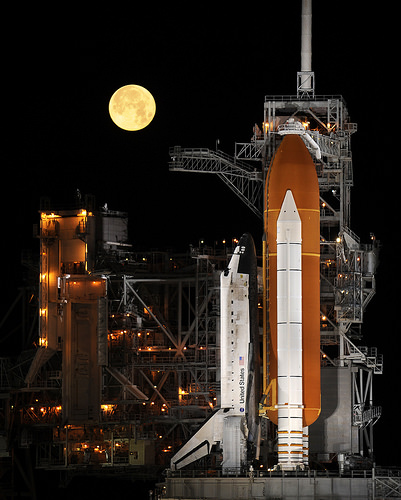[/caption]
2nd UPDATE: (6:45 EDT) Mission managers have reset the launch of Discovery on STS-119 to no earlier than Sunday, March 15 at 7:43:38 p.m. EDT. Engineers will troubleshoot problems with a leaky hydrogen line.
UPDATE: (2:25 pm EDT) Launch scrub due to leak in hydrogen line while fueling. Rats! Latest news is that NASA will try again tomorrow to launch. The launch time has now been set for 8:54 pm EDT on Thursday, March 12.
Space shuttle Discovery will light up the night sky with a Wednesday Thursday Sunday evening launch, at 9:20 pm EDT (1:20 am GMT). 8:54 pd EDT (12:54 am GMT). 7:43 pm EDT (11:443 pm GMT). Mission managers have given the go-ahead for filling the external fuel tank with the super-cold propellants and the weather looks favorable, so things are looking good for an on-time launch. Night launches are always gorgeous to watch, and there are a plethora of ways to follow the launch. First and foremost, if you live along the Eastern coast of the United States, you may be able to see the shuttle rise from Earth with your own eyes! If the skies are clear in your area, look low in the sky at launch time, about 5 to 15 degrees above the horizon, depending on your viewing point. You’ll see a light moving quite fast, streaking across 90 degrees of azimuth in less than a minute.
Below is a list of the different webcasts and feeds that will be showing the launch live for those of us that don’t live on the US Eastern seaboard. Plus, I’ll be Twittering during pre-launch and launch if you want to join me.
Of course, the launch will be shown live on NASA TV. If NASA TV isn’t available in your area via cable or satellite, watch it on the web.
Spaceflightnow.com will be having a live webcast featuring Miles O’Brien, former astronaut LeRoy Chiao and David Waters starting at at 4:30 p.m. EDT (2030 GMT) Wednesday.
SpaceVidCast will also be showing a live feed, with interesting banter from their hosts, Cariann and Ben Higginbotham.
Commander Lee Archambault will lead Discovery’s crew of seven, along with Pilot Tony Antonelli, and Mission Specialists Joseph Acaba, John Phillips, Steve Swanson, Richard Arnold and Japan Aerospace Exploration Agency astronaut Koichi Wakata on mission STS-119 to the International Space Station.
The Discovery crew members will bring the S6 truss segment and install the final set of power-generating solar arrays to the International Space Station. The S6 truss will complete the backbone of the station and provide one-fourth of the total power needed to support a crew of six. It also will increase the surface area of the ISS to over an acre. The sunlight reflected from this surface area will make the ISS the 2nd brightest object in the night sky, after the moon. Here’s info on where and how to look for the ISS in the night sky.


Would it be worth making an effort in Connecticut?
I like the Bill Ingalls photograph. Well done.
#@$!*#!!! This launch has been postponed because of a leak. The weather today is perfect for a launch too. !%@#^!!!!
Dave, it’s a long shot, but maybe only one way to find out. Find the highest accessible spot out of town, hope for clear skies and bring a camera. The worst problem is that 7:45pm is not yet fully dark. We might catch the top of the arc, or maybe even reflective light…with luck…
I know most of you will disagree with me, but I really don’t think they should be sending that thing up today. Just two days ago, they found a serious problem with it. Shouldn’t there be more investigation before it is launched?